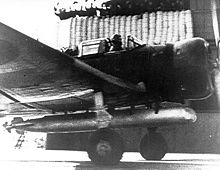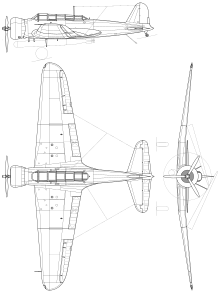Nakajima B5N
| Nakajima B5N | |
|---|---|

|
|
| Type: | Torpedo bombers |
| Design country: | |
| Manufacturer: | |
| First flight: |
January 1937 |
| Number of pieces: |
circa 1150 |

The Nakajima B5N ( Allied code name : Kate ) was a Japanese torpedo bomber and horizontal bomber from the Second World War .
Unlike its outdated allied counterparts TBD Devastator and Fairey Swordfish , the B5N was the most modern and powerful carrier torpedo bomber in the world at the beginning of the Second World War (in the current version B5N2). On the larger aircraft carriers , the machine was against the successor model until early 1944 Nakajima B6N replaced Tenzan ( "Jill"), to the smaller carriers and land bases from the B5N2 remained until the war ended in use, most recently as a kamikaze plane .
Development history and use
The B5N was designed by a design team led by Nakamura Katsuji by the Navy specification 10-Shi in 1935 and introduced as an interim solution should biplane of the type Yokosuka B4Y ( "Jean") to replace. Internally it was called Type K at Nakajima and was able to prevail against the competitor Mitsubishi B5M . Innovations included Fowler flaps and controllable pitch propellers . The first prototype flew in January 1937, and the first series version B5N1 went into production in November 1937 with the alternative designation "Type 97 Model 1" and from 1938 "Model 11 carrier attack bomber" after various improvements. From 1939, the first carrier squadrons were converted to the new type ( Sōryū , hereinafter Hiryū ).
The B5N was used in parallel, initially mainly from land, in the Second Sino-Japanese War (1937–1945). Overall, this did not result in the need for major modifications, but general developments provided an opportunity to increase engine performance. This resulted in the model 12 (or in the new Japanese designation system: the B5N2), which is identical except for the more powerful 1000 HP engine "Nakajima Sakae 11", a slightly smaller propeller (partly with spinner cap ) and the new, narrower engine fairing with the model 11 was. The increase in performance was not significant because of the simultaneous increase in weight, but the new engine was significantly more reliable and the view from the cockpit was better because of the narrower fairing, so that the advantages justified the conversion to series production. By the beginning of the Pacific War in December 1941, all the carrier torpedo bomber squadrons of the Japanese fleet aircraft carriers were converted to the B5N2 except for the training and auxiliary carrier Hōshō .
The B5N2 were also used in the attack on Pearl Harbor on December 7, 1941, where they were u. a. the battleship Arizona was sunk by bombs and other ships by torpedoes. The B5N2 also contributed to the successes of the Japanese carrier weapon during the great naval battles in the Pacific in 1942
The B5N served as the basis for the successor Nakajima B6N , it remained in use on the large fleet aircraft carriers until spring 1944 and then served as a target aircraft, for fighting submarines and in the B5N2-K version as a trainer. Some machines received radars and magnetic anomaly detectors. However, the type remained in service at the front until the end of 1944, especially on smaller aircraft carriers and land bases. In the naval battle in the Philippine Sea in June 1944, a total of 18 B5N2s were still on board, mainly as reconnaissance aircraft, on the Japanese fleet carriers Zuihō , Chiyoda and Chitose . The B5N2 were last involved as bombers in the unsuccessful defense of the Philippines in October 1944. The last on-board squadron of a fleet carrier was the B5N2 group of the carrier Chiyoda , deployed in October 1944 in the battle of Cape Engano for submarine hunting ; Chitose and Zuiho had finally converted to B6N in September 1944. The B5N2 remained stationed on escort carriers until 1945; its last active carrier missions took place from the Kaiyo .
A total of 1149 B5N machines of all variants were built. Complete copies no longer exist today. However, a B5N2 that was recovered from the Kuril Islands in 2003 is currently being restored by a British private collector.
Technical specifications
| Parameter | Data Nakajima B5N2 |
|---|---|
| crew | 3 |
| length | 10.30 m |
| span | 15.52 m |
| height | 3.70 m |
| Wing area | 37.7 m² |
| Wing extension | 6.4 |
| Empty mass | 2,279 kg |
| Takeoff mass | 3,800 kg |
| Max. Takeoff mass | 4,100 kg |
| drive | a Nakajima-Sakae -11- radial engine with 1,000 HP (735 kW) |
| Top speed | 378 km / h at an altitude of 3,600 meters |
| Service ceiling | 8,260 m |
| Range | 1,991 km |
| Armament | a Type 92 7.7 mm MG, an 800 kg torpedo or various bomb loads of up to 800 kg |
swell
- René J. Francillon: Japanese Aircraft of the Pacific War. Putnam, 2nd edition 1979/1994, pp. 411-416.
- Michel Ledet: Samourai sur porte-avions - Les groupes embarqués Japonais et leurs porte-avions 1922–1944. Lela Presse, Outreau 2005, pp. 484-488.
- Eduardo Cea: The Air Force of the Imperial Japanese Navy Vol. I. Carrier-Based Aircraft 1922–1945, AF Editions, Valaldolid o. J.
Web links
Individual evidence
- ^ René J. Francillon, Japanese Aircraft of the Pacific War , Putnam, 2nd edition 1979/1994, p. 411; Joseph Mizrahi (Ed.), Handicapping the Combat Aircraft of the Pacific War , Wings Vol. 15 No. 3 pp. 24–55, on p. 41: "best torpedo bomber in the world 1941".

